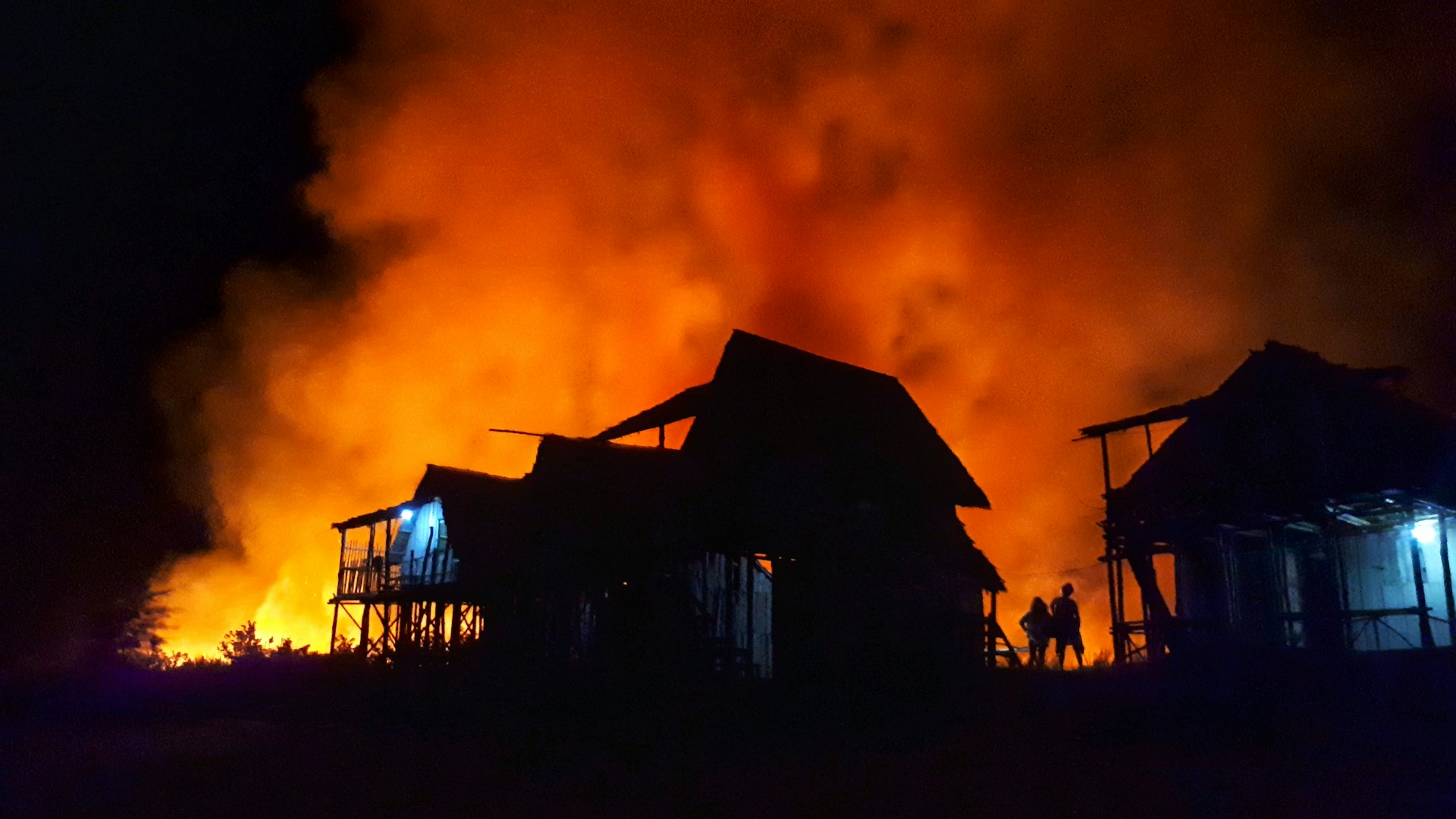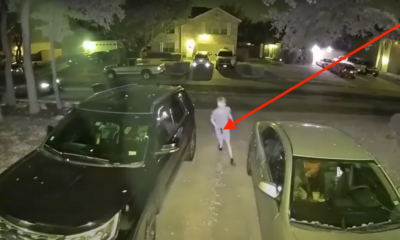Preparedness
Homeowner Defends Against Intruder in Quiet Las Vegas Neighborhood

A Las Vegas homeowner found himself in a life-threatening situation early Thursday morning when a male suspect began breaking windows and attempting to enter his residence. This incident has left the usually tranquil neighborhood near Torrey Pines Drive and Flamingo Drive in shock.
Jennifer Sauberan, a long-time resident, expressed her disbelief to KLAS-TV.
“I was shocked,” she said.
“Because it’s a very quiet neighborhood.”
Sauberan reflected on how close she might have come to being a victim herself.
“I was just thinking, ‘Oh, my God, what if I hadn’t come back the night before?’” she wondered.
“It could have been my house.”
Having lived in the area for decades without any concerns, Sauberan now feels a heightened sense of vulnerability.
“It was so unexpected,” she remarked.
“We never have anything ever happen in this neighborhood, ever.”
The homeowner, whose name has not been released, called 911 around 7:40 a.m. to report a strange male breaking windows and attempting to gain entry into his home, according to Las Vegas Metropolitan Police Homicide Lieutenant Jason Johansson.
“The man was not listening to what they were telling him,” Johansson stated.
“He was acting extremely irrational as they continued to tell him to leave the property.”
When the suspect moved toward the front door, the homeowner made the decision to shoot. The suspect was found in the driveway by officers and later died at the hospital.
Johansson mentioned that there are “self-defense” elements involved in this case, and he does not expect the homeowner to face charges. However, the final decision will be made by the Clark County District Attorney.
Anyone with additional information is encouraged to contact the LVMPD Homicide Section by phone at 702-828-3521 or via email at homicide@lvmpd.com. For those wishing to remain anonymous, Crime Stoppers can be reached at 702-385-5555 or online.
In response to the incident, Sauberan has taken further steps to secure her home.
“I have cameras around my house now,” she shared.
“I put them up more recently, but then I put in flood lights and stuff because [criminal activity] makes me a little bit nervous sometimes.”
This event has undoubtedly shaken a community that prides itself on its peaceful environment, reminding residents of the importance of preparedness and vigilance.
Watch a local news report about the incident below:
Let us know what you think, please share your thoughts in the comments below.

Preparedness
The Top Survival Foods That Last for Years (and Actually Taste Good)

When emergencies strike, whether it’s a power outage, a storm, or a supply shortage the food you have on hand can make all the difference. Building a practical, long-lasting food stockpile doesn’t mean settling for bland meals or astronaut rations. With a bit of planning, you can create a pantry that’s nutritious, comforting, and ready for anything.
1. Rice: The Reliable Staple
Rice is a survival classic for a reason. It’s inexpensive, lightweight, and can last over 20 years if stored properly in airtight containers with oxygen absorbers. Pair it with beans, canned vegetables, or spices to make complete meals. Brown rice offers more nutrition but has a shorter shelf life about six months, so white rice is the go-to for long-term storage.
2. Beans: Protein That Never Quits
Dried or canned, beans are a powerhouse of protein, fiber, and minerals. They fill you up fast and combine perfectly with rice for a balanced diet. Dried beans keep for decades, while canned varieties are ready to eat in minutes just check expiration dates every year.
3. Peanut Butter: The Energy Saver
Packed with calories, healthy fats, and protein, peanut butter is a morale booster when fresh food is scarce. It requires no cooking, lasts up to two years unopened, and offers comfort in uncertain times. It’s especially useful for families with children.
4. Canned Meats and Fish
Tuna, chicken, salmon, and even Spam are excellent sources of protein and essential fats. Canned meats last several years and can be eaten cold if cooking isn’t an option. Rotate them every 18–24 months to maintain freshness and flavor.
5. Oats: Breakfast and Beyond
Oats are nutrient-dense, easy to prepare, and versatile, you can make oatmeal, granola, or even use them as a flour substitute. Stored in a sealed container, they’ll last for years and provide sustained energy.
6. Honey: Nature’s Forever Food
Honey never spoils. Archaeologists have found jars of honey thousands of years old that are still edible. It’s a natural sweetener, cough remedy, and wound treatment. Keep it sealed and store at room temperature if it crystallizes, just warm it gently.
7. Powdered Milk and Eggs
These are perfect for baking, cereal, or protein shakes when fresh dairy isn’t available. Properly stored in cool, dry places, powdered milk lasts up to 10 years, while powdered eggs can stay good for up to 5.
8. Salt and Seasonings
Salt isn’t just a flavor enhancer, it’s a preservative and electrolyte source. Pair it with spices and dried herbs to make otherwise dull survival meals much more enjoyable. Comfort food matters more than you think during stressful times.
9. Dried Fruits and Nuts
These provide quick energy, healthy fats, and essential vitamins. They’re ideal for snacking or adding to cereals and trail mixes. Store them in airtight containers to extend their shelf life up to a year or more.
10. Freeze-Dried Meals
Modern freeze-dried meals have come a long way, they’re lightweight, tasty, and can last 25 years or longer. Just add water and you’ve got instant lasagna, chili, or chicken teriyaki. They’re expensive, but worth including for convenience.
Final Thought
Survival food isn’t about hoarding, it’s about being smart. Build your stock gradually, rotating items so nothing goes to waste. Focus on variety, nutrition, and comfort foods that boost morale. The best survival pantry is one that you’d happily eat from even without an emergency.
Nature and Wildlife
7 Proven Ways to Survive Extreme Cold During Winter

Winter can be beautiful, but when temperatures drop below freezing, it quickly becomes dangerous, especially for older adults or anyone with health conditions that affect circulation or mobility. Prolonged exposure to extreme cold can lead to frostbite, hypothermia, and respiratory problems. Whether you live in the countryside, a city apartment, or a rural cabin, preparing before the cold strikes can make all the difference. Here are seven proven ways to stay warm, safe, and healthy through the harshest winter conditions.
1. Dress in Smart, Protective Layers
Layering is your body’s first line of defense against cold. Rather than piling on one heavy jacket, wear several thin, insulating layers. Start with a base layer made of synthetic or wool fabric that pulls sweat away from your skin. Add an insulating layer like fleece or down to trap body heat, and finish with a waterproof and windproof outer shell to block snow and icy winds.
Don’t neglect extremities wear insulated gloves, a thermal hat, a scarf, and warm socks. If you’re indoors, cozy slippers and thermal leggings can also help you stay warm without overusing your heating system.
2. Seal In Warmth and Block Out the Cold
Even small drafts can drain heat from your home. Inspect doors and windows for gaps, then use weather stripping, caulk, or draft stoppers to seal them. Hang thick curtains and close them at night to trap heat inside. If you have unused rooms, close their vents and doors to concentrate warmth where you spend the most time.
Rugs, towels, or blankets rolled up at the bottom of doors also help prevent cold air from seeping in. If possible, consider window insulation kits inexpensive plastic sheets that add an extra layer of protection.
3. Stay Dry at All Costs
Moisture is a silent danger in cold weather. Wet clothing can cause body heat to evaporate rapidly, leading to hypothermia even in temperatures above freezing. Always keep an extra set of dry clothes nearby. If you must go outdoors, wear waterproof boots and gloves. When you come inside, remove damp shoes and clothes immediately and replace them with dry layers.
4. Create a “Warm Room” for Emergencies
If your heating system fails or power goes out, select one small, well-insulated room to serve as your heat zone. Hang blankets over windows and doors to keep warmth in. Gather blankets, sleeping bags, and all household members (including pets) in that space. The shared body heat will make the room more livable. You can use candles, hand warmers, or small battery-powered heaters to supplement warmth just ensure proper ventilation and avoid open flames near anything flammable.
5. Eat and Drink to Fuel Warmth
Your body is like a furnace, it needs fuel to stay warm. During extreme cold, focus on nutrient-rich, high-calorie foods like nuts, peanut butter, whole grains, and soups. Warm drinks such as tea, coffee, or broth can help maintain your core temperature. Avoid alcohol and caffeine in large amounts, as they can dehydrate you and give a false sense of warmth.
Drinking plenty of water is equally important. Cold weather can dull your thirst, but dehydration makes it harder for your body to regulate temperature.
6. Build and Maintain a Winter Survival Kit
A well-stocked emergency kit can be a lifesaver. Include thermal blankets, batteries, flashlights, a first-aid kit, bottled water, energy bars, a whistle, and a hand-crank radio. If you live in a snowy area, add snow shovels, cat litter (for traction), and jumper cables for your car. Recharge portable power banks regularly, and keep an extra set of warm clothes in a waterproof bag in case you need to evacuate or travel.
7. Recognize and Respond to Cold-Related Illnesses
Knowing the warning signs of hypothermia and frostbite can prevent tragedy.
- Hypothermia begins with shivering, fatigue, and confusion, then progresses to slurred speech and drowsiness.
- Frostbite causes numb, pale, or hard skin, especially on fingers, toes, and ears.
If you suspect either condition, move to a warm area immediately, replace wet clothing, and warm the person gradually using blankets or body heat. Never apply direct heat, like a hot water bottle or hair dryer, as it can damage skin and tissue.
Final Thoughts
Surviving extreme cold is about preparation, awareness, and calm decision-making. By layering properly, securing your home, staying dry, and having an emergency plan, you can protect yourself and your loved ones through even the harshest winter storms. Remember, it’s not just about enduring the cold; it’s about staying comfortable, confident, and safeuntil spring returns.
Preparedness
Smart Person’s Checklist: 10 Things You’ll Wish You Had When Disaster Strikes

Because peace of mind beats panic every time
When a big storm’s coming, the news spreads fast. Shelves empty, gas stations fill up, and suddenly everyone’s buying bottled water like it’s gold. The truth is, once panic buying starts, it’s already too late. Real preparedness isn’t about fear it’s about peace of mind. The best time to get ready is when things still feel normal.
Here are ten simple, affordable items you can stock quietly now so you’re not scrambling later.
1. Water and Water Filters
Start with the basics: one gallon per person per day for at least three days. Keep bottled water handy, but also grab a small filter straw or purification tablets for backup. Clean water matters more than anything else when supplies run short.
2. Non-Perishable Food
You don’t need fancy freeze-dried meals. A few weeks’ worth of canned goods, rice, oats, peanut butter, and protein bars go a long way. Choose foods you actually eat, rotate them out as part of your normal pantry.
3. First-Aid Kit and Medications
Every home needs one. Bandages, antiseptic, gloves, and basic medicines like pain relievers and allergy pills can make a huge difference. If you take prescription medication, try to keep at least a few extra days’ supply on hand.
4. Flashlights and Extra Batteries
When the power goes out, light is everything. Stock a few small LED flashlights and a headlamp for hands-free use. Don’t forget extra batteries or a crank-powered option that never needs charging.
5. Portable Charger or Power Bank
Phones are lifelines during emergencies. Keep a charged power bank in your bag or car. Solar versions are great backups if you’re stuck without power for days.
6. Trash Bags and Zip Ties
Sounds simple, but trash bags are a survival essential. They can collect waste, store supplies, or even serve as ponchos or tarps. Pair them with a handful of zip ties one of the most underrated tools for securing gear or sealing openings.
7. Manual Can Opener
If your food storage depends on cans, make sure you can open them without electricity. A sturdy manual can opener can save you a lot of frustration (and hungry hours).
8. Multi-Tool or Pocket Knife
A good multi-tool replaces an entire toolbox in an emergency. Cutting rope, fixing leaks, opening packages you’ll use it more often than you think.
9. Basic Hygiene Supplies
Soap, toothbrushes, wet wipes, and feminine products often get overlooked. Staying clean keeps morale up and illness down, especially when running water isn’t guaranteed.
10. Emergency Cash
If card readers go down, cash is still king. Keep small bills in a waterproof envelope somewhere safe but easy to grab.
Final Thought
Preparedness isn’t about hoarding or panic, it’s about independence and calm. When something unexpected happens, the people who’ve planned ahead are the ones helping others instead of fighting for supplies.
📝 Starter Supply Checklist
☑ Water (1 gallon per person per day)
☑ Food for 3–7 days
☑ First-aid kit and medicines
☑ Flashlights + batteries
☑ Power bank or solar charger
☑ Trash bags + zip ties
☑ Manual can opener
☑ Multi-tool or knife
☑ Hygiene essentials
☑ Small cash reserve
-

 Tactical2 years ago
Tactical2 years ago70-Year-Old Fends Off Intruder with Lead-Powered Message
-

 Tactical2 years ago
Tactical2 years agoVape Shop Employee Confronts Armed Crooks, Sends Them Running
-

 Preparedness1 year ago
Preparedness1 year agoEx-Ballerina’s Guilty Verdict Sends Tremors Through Gun-Owner Community
-

 Off The Grid3 weeks ago
Off The Grid3 weeks ago10 Foods That Could Save Your Life When Grocery Shelves Are Empty
-

 Preparedness1 year ago
Preparedness1 year agoGood Samaritan Saves Trooper in Harrowing Interstate Confrontation
-

 Tactical2 years ago
Tactical2 years agoMidnight SUV Theft Interrupted by Armed Homeowner’s Retaliation
-

 Survival Stories2 years ago
Survival Stories2 years agoEmily’s 30-Day Experience of Being Stranded on a Desert Island
-

 Preparedness4 months ago
Preparedness4 months agoHow Much Gasoline Should You Store for Emergencies?
Don
October 9, 2024 at 12:52 pm
That scumbag won’t be stealing ever again. This woman should be given an award.
Paul
October 9, 2024 at 3:38 pm
The MAN, did what he should have. Criminals that pay with their lives, never repeat! It’s time they start paying more frequently, it’s time government started backing us, and not the criminals! If the woman wants a safer house, she should arm herself and be prepared. Lights and cameras don’t keep criminals out, if their intent on committing a crime, guns stop them cold!